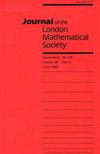Modularity of d $d$ -elliptic loci with level structure
IF 1.2
2区 数学
Q1 MATHEMATICS
Journal of the London Mathematical Society-Second Series
Pub Date : 2025-06-25
DOI:10.1112/jlms.70212
引用次数: 0
Abstract
We consider the generating series of special cycles on , with full level structure, valued in the cohomology of degree . The modularity theorem of Kudla–Millson for locally symmetric spaces implies that these series are modular. When , the images of these loci in are the -elliptic Noether–Lefschetz loci, which are conjectured to be modular. In the Appendix, it is shown that the resulting modular forms are nonzero for when and .



具有水平结构的d$ d$ -椭圆轨迹的模块化
考虑a1 (N) × a1 (N)上的特殊环的生成级数$\mathcal {A}_1(N)\times \mathcal {A}_g(N)$,具有全N阶$N$结构,值为2g次上同调$2g$。局部对称空间的Kudla-Millson模定理表明这些级数是模的。当N = 1 $N=1$时,这些基因座在A g $\mathcal {A}_g$中的图像为d $d$ -椭圆Noether-Lefschetz基因座,推测其为模。在附录中,结果表明,当N大于或等于11 $N\geqslant 11$且N≠12 $N\ne 12$时,所得到的模形式对于g = 2 $g=2$是非零的。
本文章由计算机程序翻译,如有差异,请以英文原文为准。
求助全文
约1分钟内获得全文
求助全文
来源期刊
CiteScore
1.90
自引率
0.00%
发文量
186
审稿时长
6-12 weeks
期刊介绍:
The Journal of the London Mathematical Society has been publishing leading research in a broad range of mathematical subject areas since 1926. The Journal welcomes papers on subjects of general interest that represent a significant advance in mathematical knowledge, as well as submissions that are deemed to stimulate new interest and research activity.

 求助内容:
求助内容: 应助结果提醒方式:
应助结果提醒方式:


